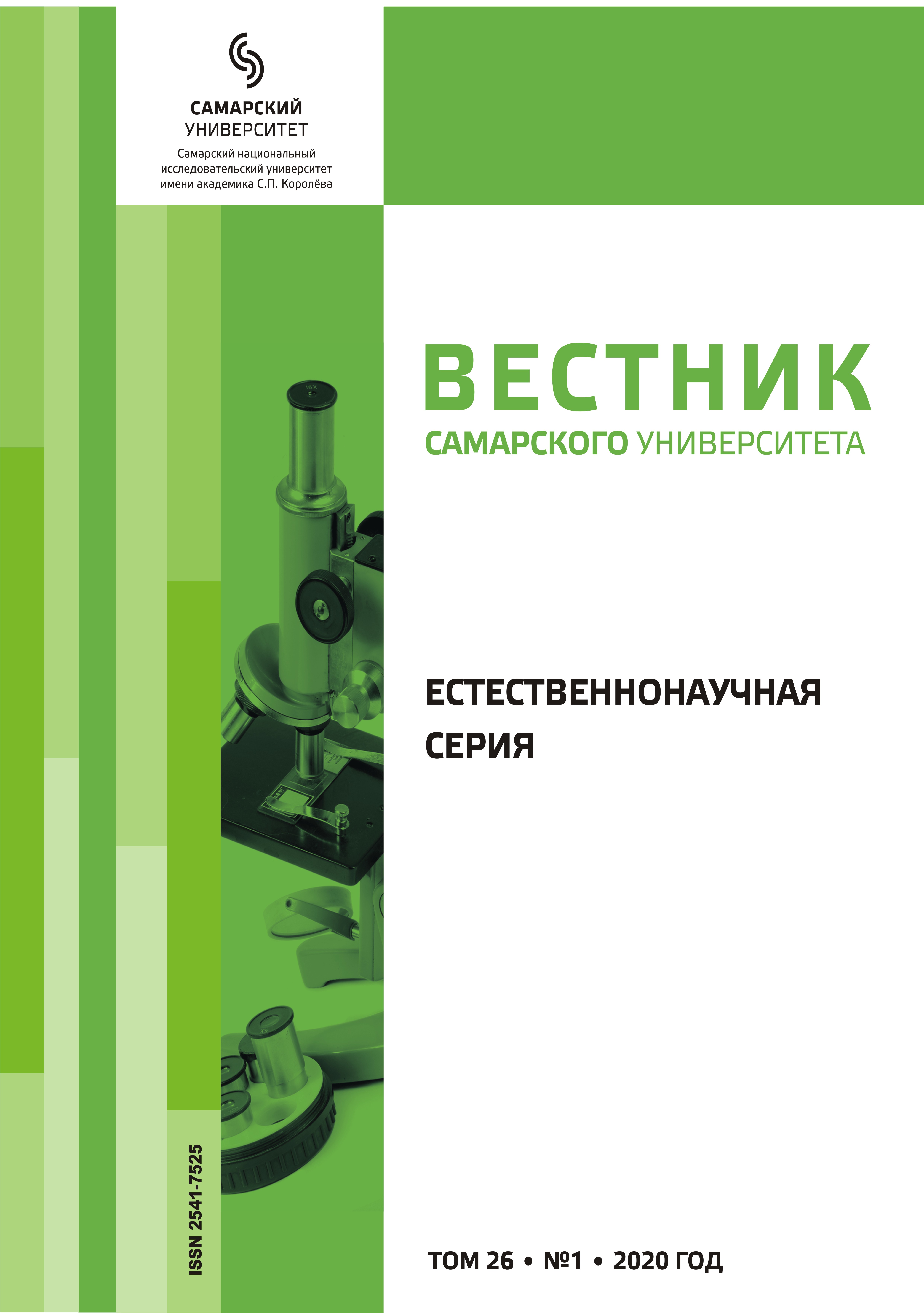Том 26, № 1 (2020)
- Год: 2020
- Статей: 6
- URL: https://journals.ssau.ru/est/issue/view/437
Статьи
К ТЕОРИИ НЕТЕРА ДВУМЕРНЫХ СИНГУЛЯРНЫХ ОПЕРАТОРОВ И ЕЁ ПРИЛОЖЕНИЯ К КРАЕВЫМ ЗАДАЧАМ ДЛЯ ЭЛЛИПТИЧЕСКИХ СИСТЕМ УРАВНЕНИЙ ЧЕТВЕРТОГО ПОРЯДКА
Аннотация
Известно, что общая теория многомерных сингулярных интегральных операторов по всему пространству En построена С.Г. Михлиным. Показано, что в двумерном случае, если символ оператора не обращается в нуль, то имеет место теория Фредгольма. Что касается операторов по ограниченной области, то здесь граница области существенно влияет на разрешимость таких операторных уравнений. В статье рассматриваются двумерные сингулярные операторы с непрерывными коэффициентами по ограниченной области, которые широко применяются во многих задачах теории дифференциальных уравнений в частных производных. В связи с этим представляет интерес установление критериев
нетеровости таких операторов в виде явных условий по их коэффициентам. В зависимости от 2m + 1 компонентов связанности определяются необходимые и достаточные условия нетеровости таких операторов и дается формула для вычисления индекса. Полученные результаты применяются к задаче Дирихле для общих эллиптических систем четвертого порядка.
 7-13
7-13


О РЕШЕНИИ НЕКОТОРЫХ ИНТЕГРО-ДИФФЕРЕНЦИАЛЬНЫХ УРАВНЕНИЙ ВЫСШЕГО ПОРЯДКА СПЕЦИАЛЬНОГО ВИДА
Аннотация
Статья посвящена решению краевых задач для линейных интегро-дифференциальных уравнений высшего порядка типа Фредгольма с дифференциальными и интегральными операторами, охватывающими степени идеального биективного линейного дифференциального оператора, обратный которому явно известен. Выводятся условия существования и единственности решений, и решения изложены в закрытом виде. Подход основан на представлении о том, что интегро-дифференциальный оператор является возмущенным дифференциальным оператором. Полученные результаты имеют как теоретическое, так и практическое значение. Метод поясняется решением двух иллюстративных задач.
 14-22
14-22


ПОЛУГРУППЫ БИНАРНЫХ ОПЕРАЦИЙ И КРИПТОСИСТЕМЫ НА ГРУППОИДАХ
Аннотация
В статье изучаются частные случаи алгебр многоместных отношений, а именно алгебры бинарных операций, определенных на элементах конечных и бесконечных множеств. Инструментальную основу исследования составляют унарная и ассоциативная бинарная операции над 3-местными отношениями, которые индуцируются операциями взятия обратного и произведения над 2-местными отношениями. Это позволяет перенести основные понятия, связанные со свойствами функциональности, инъективности, сюръективности и тотальности 2-местных отношений, на 3-местные отношения и сформулировать критерии выполнения подобных свойств в терминах упорядоченных полугрупп. Возникающая при этом система последовательных вложенний моноида квазигрупповых операций в моноид бинарных операций, а затем в моноид 3-местных отношений соответствует последовательным вложениям моноидов биекций, функций и 2-местных отношений. Разработанный аппарат позволяет применять к бинарным операциям и соответствующим им конечным группоидам быстрые алгоритмы возведения в степень для построения элементов циклических полугрупп, которые используются в современной асимметричной криптографии. Возможное приложение полученных результатов демонстрируется на примере протокола Диффи — Хелмана — Меркла открытого распределения ключей.
 23-51
23-51


ЗАДАЧИ ДИФФЕРЕНЦИАЛЬНОЙ И ТОПОЛОГИЧЕСКОЙ ДИАГНОСТИКИ. ЧАСТЬ 4. ЗАДАЧА ДИАГНОСТИРОВАНИЯ (СЛУЧАЙ ТОЧНЫХ ТРАЕКТОРНЫХ ИЗМЕРЕНИЙ)
Аннотация
Данная статья является четвертой работой цикла, при этом для случая точных траекторных измерений формулируются постановка задачи диагностирования, теорема диагностирования и, как следствие теоремы, два алгоритма диагностирования. Рассмотрена методика априорного счета констант, которые в случае использования первого алгоритма диагностирования требуется запоминать в программе диагностирования на компьютере, и других параметров алгоритма. Второй алгоритм не требует запоминания констант, а основан на поиске минимального значения функционала диагностирования из его значений, полученных в процессе диагностирования для априори выбранного набора опорных неисправностей. Обсуждаются различные обобщения теоремы диагностирования: вопросы применимости полученных алгоритмов диагностики при использовании вектора диагностирования меньшей, чем вектор состояния, размерности, и в случае непрерывной экспресс-диагностики без применения поверхности контроля, задача о выборе “минимального” времени диагностирования, задача диагностирования неисправностей, происшедших в окрестностях опорных
невырожденных неисправностей и непредусмотренных априорным списком, рассмотрены другие функционалы, решающие задачу диагностирования. Сформулирована расширенная постановка задачи
диагностирования, решение которой осуществимо с помощью предложенных алгоритмов.
 52-68
52-68


ИЗВЛЕЧЕНИЕ ПАРАМЕТРОВ МЕХАНИКИ РАЗРУШЕНИЯ ИЗ КОНЕЧНО-ЭЛЕМЕНТНОГО АНАЛИЗА: АЛГОРИТМЫ И ПРОЦЕДУРЫ
Аннотация
В статье описываются новые алгоритмы и процедуры, предложенные для определения параметров механики разрушения на основе конечно-элементного анализа с использованием переопределенного метода. Используется многопараметрическое описание поля напряжений у вершины трещины. Показано, что алгоритмы и процедуры, основанные на многопараметрических представлениях полей напряжений в асимптотической форме, являются мощным инструментом надежного и точного определения масштабных множителей — параметров механики разрушения. Методика направлена на определение коэффициентов разложения ряда Вильямса из конечно-элементного анализа и основана на переопределенном подходе. Методология проиллюстрирована и применена к нескольким случаям образцов с трещинами. Приведены примеры конфигурации, исследованные с помощью метода цифровой фотоупругости. Результаты конечно-элементного анализа сравниваются с экспериментами, проведенными методом цифровой фотоупругости. Результаты находятся в хорошем согласии друг с другом. Напряжения, полученные методом конечных элементов, хорошо согласуются с изохроматическими картинами полос, полученными методом фотоупругости. Дано разъяснение для того, чтобы дать пользователю руководство о том, как лучше всего подходить к реализации метода с практической точки зрения.
 69-77
69-77


УТОЧНЕННЫЙ РАСЧЕТ УСТАНОВИВШЕЙСЯ ПОЛЗУЧЕСТИ ВРАЩАЮЩЕГОСЯ ДИСКА И ПЛАСТИНЫ С КРУГОВЫМ ОТВЕРСТИЕМ В УСЛОВИЯХ ПОЛЗУЧЕСТИ МЕТОДОМ КВАЗИЛИНЕАРИЗАЦИИ
Аннотация
В статье получены приближенные решения задач о ползучести вращающегося диска и о всестороннем растяжении пластины с центральным круговым отверстием в условиях ползучести методом квазилинеаризации. Основной целью исследования был анализ поведения решений в зависимости от значения показателя ползучести. С помощью метода квазилинеаризации найдены четыре приближения решения задачи. Показано, что построенные приближения сходятся к предельному численному решению задачи. Интересной особенностью данной задачи является тот факт, что максимальное значение тангенциального напряжения достигается не на круговом контуре, а во внутренней точке пластины. Показано, что метод квазилинеаризации является эффективным методом решения нелинейных задач механики деформируемого твердого тела.
 78-94
78-94




















